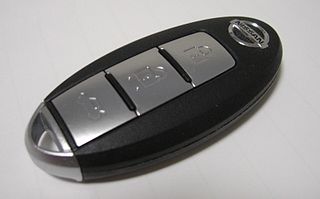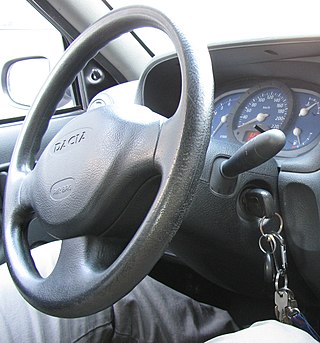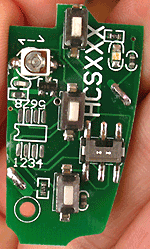In cryptography, pseudorandom noise (PRN) is a signal similar to noise which satisfies one or more of the standard tests for statistical randomness. Although it seems to lack any definite pattern, pseudorandom noise consists of a deterministic sequence of pulses that will repeat itself after its period.
In telecommunications, squelch is a circuit function that acts to suppress the audio output of a receiver in the absence of a strong input signal. Essentially, squelch is a specialized type of noise gate designed to suppress weak signals. Squelch is used in two-way radios and VHF/UHF radio scanners to eliminate the sound of noise when the radio is not receiving a desired transmission.
A prefix code is a type of code system distinguished by its possession of the "prefix property", which requires that there is no whole code word in the system that is a prefix of any other code word in the system. It is trivially true for fixed-length codes, so only a point of consideration for variable-length codes.

In electronics, a remote control is an electronic device used to operate another device from a distance, usually wirelessly. In consumer electronics, a remote control can be used to operate devices such as a television set, DVD player or other digital home media appliance. A remote control can allow operation of devices that are out of convenient reach for direct operation of controls. They function best when used from a short distance. This is primarily a convenience feature for the user. In some cases, remote controls allow a person to operate a device that they otherwise would not be able to reach, as when a garage door opener is triggered from outside.

In cryptography, ciphertext or cyphertext is the result of encryption performed on plaintext using an algorithm, called a cipher. Ciphertext is also known as encrypted or encoded information because it contains a form of the original plaintext that is unreadable by a human or computer without the proper cipher to decrypt it. This process prevents the loss of sensitive information via hacking. Decryption, the inverse of encryption, is the process of turning ciphertext into readable plaintext. Ciphertext is not to be confused with codetext because the latter is a result of a code, not a cipher.
A cryptographically secure pseudorandom number generator (CSPRNG) or cryptographic pseudorandom number generator (CPRNG) is a pseudorandom number generator (PRNG) with properties that make it suitable for use in cryptography. It is also referred to as a cryptographic random number generator (CRNG).

Radio control is the use of control signals transmitted by radio to remotely operate a device. Examples of simple radio control systems are garage door openers and keyless entry systems for vehicles, in which a small handheld radio transmitter unlocks or opens doors. Radio control is also used for control of model vehicles from a hand-held radio transmitter. Industrial, military, and scientific research organizations make use of radio-controlled vehicles as well. A rapidly growing application is control of unmanned aerial vehicles for both civilian and military uses, although these have more sophisticated control systems than traditional applications.

Coding theory is the study of the properties of codes and their respective fitness for specific applications. Codes are used for data compression, cryptography, error detection and correction, data transmission and data storage. Codes are studied by various scientific disciplines—such as information theory, electrical engineering, mathematics, linguistics, and computer science—for the purpose of designing efficient and reliable data transmission methods. This typically involves the removal of redundancy and the correction or detection of errors in the transmitted data.
A replay attack is a form of network attack in which valid data transmission is maliciously or fraudulently repeated or delayed. This is carried out either by the originator or by an adversary who intercepts the data and re-transmits it, possibly as part of a spoofing attack by IP packet substitution. This is one of the lower-tier versions of a man-in-the-middle attack. Replay attacks are usually passive in nature.
Key generation is the process of generating keys in cryptography. A key is used to encrypt and decrypt whatever data is being encrypted/decrypted.

A garage door opener is a motorized device that opens and closes a garage door controlled by switches on the garage wall. Most also include a handheld radio remote control carried by the owner, which can be used to open and close the door from a short distance.

A smart key is an electronic access and authorization system that is available either as standard equipment or an option in several car designs. It was developed by Siemens in 1995 and introduced by Mercedes-Benz under the name "Keyless-Go" in 1998 on the W220 S-Class, after the design patent was filed by Daimler-Benz on May 17, 1997.

A car key or an automobile key is a key used to open and/or start an automobile. Modern key designs are usually symmetrical, and some use grooves on both sides, rather than a cut edge, to actuate the lock. It has multiple uses for the automobile with which it was sold. A car key can open the doors, as well as start the ignition, open the glove compartment and also open the trunk (boot) of the car. Some cars come with an additional key known as a valet key that starts the ignition and opens the driver's side door, but prevents the valet from gaining access to valuables that are located in the trunk or the glove box. Some valet keys, particularly those to high-performance vehicles, go so far as to restrict the engine's power output to prevent joyriding. Recently, features such as coded immobilizers have been implemented in newer vehicles. More sophisticated systems make ignition dependent on electronic devices, rather than the mechanical keyswitch. A number of these systems, such as KeeLoq and Megamos Crypto have been demonstrated to be weak and vulnerable to cryptanalytic attacks.

A remote keyless system (RKS), also known as remote keyless entry (RKE) or remote central locking, is an electronic lock that controls access to a building or vehicle by using an electronic remote control (activated by a handheld device or automatically by proximity). RKS largely and quickly superseded keyless entry, a budding technology that restrictively bound locking and locking functions to vehicle-mounted keypads.
Microchip Technology Incorporated is a publicly listed American corporation that manufactures microcontroller, mixed-signal, analog, and Flash-IP integrated circuits. Its products include microcontrollers, Serial EEPROM devices, Serial SRAM devices, embedded security devices, radio frequency (RF) devices, thermal, power, and battery management analog devices, as well as linear, interface and wireless products.
KeeLoq is a proprietary hardware-dedicated block cipher that uses a non-linear feedback shift register (NLFSR). The uni-directional command transfer protocol was designed by Frederick Bruwer of Nanoteq (Pty) Ltd., the cryptographic algorithm was created by Gideon Kuhn at the University of Pretoria, and the silicon implementation was by Willem Smit at Nanoteq (Pty) Ltd in the mid-1980s. KeeLoq was sold to Microchip Technology Inc in 1995 for $10 million. It is used in 'hopping code' encoders and decoders such as NTQ105/106/115/125D/129D, HCS101/2XX/3XX/4XX/5XX and MCS31X2. KeeLoq has been used in many remote keyless entry systems by such companies like Chrysler, Daewoo, Fiat, Ford, GM, Honda, Mercedes-Benz, Toyota, Volvo, Volkswagen Group, Clifford, Shurlok, and Jaguar.

Radio is the technology of communicating using radio waves. Radio waves are electromagnetic waves of frequency between 3 hertz (Hz) and 300 gigahertz (GHz). They are generated by an electronic device called a transmitter connected to an antenna which radiates the waves. They are received by another antenna connected to a radio receiver. In addition to communication, radio is used for radar, radio navigation, remote control, remote sensing, and other applications.

Samy Kamkar is an American privacy and security researcher, computer hacker and entrepreneur. At the age of 16, he dropped out of high school. One year later, he co-founded Fonality, a unified communications company based on open-source software, which raised over $46 million in private funding. In 2005, he created and released the fastest spreading virus of all time, the MySpace worm Samy, and was subsequently raided by the United States Secret Service under the Patriot Act. He also created SkyJack, a custom drone which hacks into any nearby Parrot drones allowing them to be controlled by its operator and created the Evercookie, which appeared in a top-secret NSA document revealed by Edward Snowden and on the front page of The New York Times. He has also worked with The Wall Street Journal, and discovered the illicit mobile phone tracking where the Apple iPhone, Google Android and Microsoft Windows Phone mobile devices transmit GPS and Wi-Fi information to their parent companies. His mobile research led to a series of class-action lawsuits against the companies and a privacy hearing on Capitol Hill. Kamkar has a chapter giving advice in Tim Ferriss' book Tools of Titans.
Automotive hacking is the exploitation of vulnerabilities within the software, hardware, and communication systems of automobiles.

Orr Dunkelman is an Israeli cryptographer and cryptanalyst, currently a professor at the University of Haifa Computer Science department. Dunkelman is a co-director of the Center for Cyber Law & Privacy at the University of Haifa and a co-founder of Privacy Israel, an Israeli NGO for promoting privacy in Israel.











